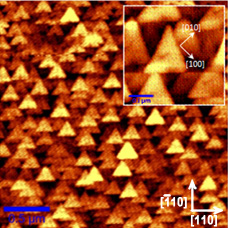- Details
- Last Updated: Tuesday, 27 December 2022 18:22
Fabrication of SiGe Quantum Dots for Third Generation Solar Cells and Characterization
Goal: Fabrication of layers of dense and uniformly distributed Quantum Dots (QDs) for Third Generation Solar Cells and IR Nanosensors, using low cost deposition technique.
Silicon-germanium nanodots are highly interesting for a wide range of applications including, but not limited to, photovoltaics, optoelectronic devices, nanosensors, high speed devices, integrated optoelectronic circuits, and quantum computing devices. We have fabricated using Rapid Thermal-Chemical Vapor (RT-CVD) SiGe nanodot layers for third generation solar cells. The nanodot layers were grown on solar grade silicon wafers. The focus was on engineering the dot size and distribution to increase IR photon harvesting. RT-CVD was chosen for it allows inducing growth conditions for nanodot self-assembling. In addition, it is a viable technology for photovoltaics for it allows deposition of large surface nanolayers at low thermal budget and at a low cost per unit area. Moreover, it offers flexibility on fabrication parameters.
|
The morphology of the nanodot layers was characterized in correlation with Ge concentration and nanoscale stresses. For that purpose, we combined atomic force microscopy (AFM), see Fig. 1, Near-field Scanning Optical Microscopy (NSOM), Confocal Raman imaging, and X-ray Photoelectron Spectroscopy (XPEEM) measurements. Raman and XPEEM provided quantum dot chemical composition in correlation with the nanodot morphology. Precise composition maps with a lateral resolution less than 40nm were obtained by XPEEM. The Ge concentration along the height of pyramidal nanodots was then deduced. |
|
Fig. 1: AFM image of SiGe nanodots grown for 3rd generation solar cells by RTCVD. |
These experimental data permitted precise evaluation of Ge segregation to the top regions of nanodots. Such result is fundamental for interpreting the electronic properties, the local bandgap variations, and confinement of charge carriers, as well as photons. The work helped understanding the effect of rapid thermal cycling (time and ramp-up) on stress and strain generation and the stress build-up in and around large nanodots (20-50nm base width) during their growth. We have been analyzing the stress, surface diffusion of the precursors, substrate-dot interdiffusion as key factors for nanodot self-assembling on the silicon surface.

